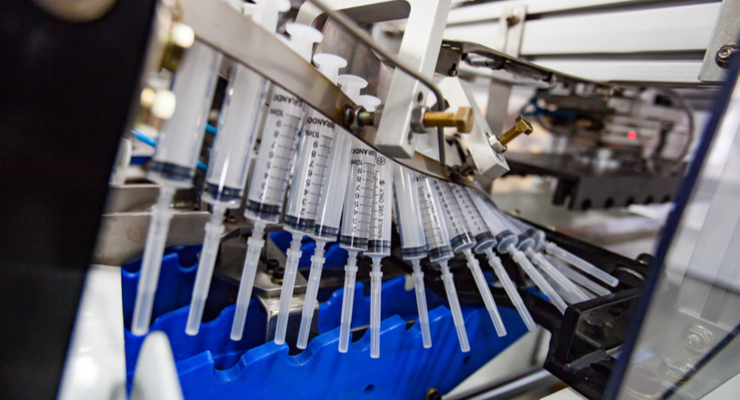Emily Newton, Editor-in-Chief, Revolutionized06.06.22
Hypodermic needles are among the most recognizable life-saving devices. When used with syringes, their hollow designs enable injecting liquids under the skin. This rapid delivery method works well for medications not suitable for ingestion because the body would not absorb them. Additionally, medications that would harm the liver if taken by mouth are good candidates for administration with these medical devices.
Although most historians link the hypodermic needle’s invention to Wood, Francis Rynd, an Irish doctor, used one as early as 1844. However, his approach didn’t involve pairing the needle with a syringe as we think of them today. Instead, Rynd’s device had a trocar to puncture the skin and a cannula that helped the medication flow into the body. There was also a spring that pulled the trocar out.
The era’s syringes were typically made of materials like silver or glass. The latter of the two materials was preferable since it allowed the person administering the injection to see the amount of liquid inside.
The short bevel has a tip angle of 30-45 degrees. Then, the long bevel’s tip angle is from 12-15 degrees. Outside of those two categories, there are other specific types. The lancet bevel provides the sharpest point for a hypodermic needle. It features a 15-degree tip angle.
When a person requires an intramuscular injection, the needles are usually 20 or 22-gauge types measuring 1-1.5 inches long. However, subcutaneous injections only go into the fatty tissue just under the skin. In those cases, the needle can only be one-half to five-eighths of an inch long, with a gauge of 25 to 30.
The higher the gauge number, the thinner the needle’s diameter, and the less discomfort when penetrating the skin. The gauge and length are usually on the needle’s sterile packaging. However, some manufacturers also use color-coded caps to help people select the desired type more quickly.
He explained that patient weight is a factor when deciding what type of hypodermic needles to choose. “Normally, we use half-inch needles,” said Feagins. “Above a certain weight—220 in females; 260 in males—you go to a one-and-a-half-inch needle.”
However, for the COVID-19 vaccine, specifically, some providers found they could get an extra dose out of each vial by using a one-inch needle.
The part of the body requiring an injection also determines the type of hypodermic needle to pick. Dr. Vinit Mahajan is an associate professor and the director of the Molecular Surgery Program at Stanford University. He explained the importance of the hypodermic needle in his work, saying that it allows injecting drugs into the eye or pulling fluid from that area.
He continued, “Perhaps the most exciting current use of the hypodermic needle is for human gene therapy. I use a 41-gauge needle with a bore size of only 100-microns to inject viruses carrying healthy genes into the subretinal space.
Mahajan said, “Our margin of error is only a few microns. The injection was typically done as a manual push of the syringe by the assistant. Now, we connect the syringe to a machine adapter that gives the surgeon foot pedal control over air pressure that drives the injection.”
This testing usually happens on a computerized mechanical machine that punctures the needle into a material designed to mimic skin. It’s then possible to pinpoint precise details, such as the amount of force needed to initially penetrate the material and the force allowing the beveled edge to widen the hole.
One issue is vaccine production is not evenly distributed worldwide. Indian vaccine manufacturers produce more than 50% of the total used globally. Besides having enough of the vaccine itself for everyone who wants one, there are logistics to work out so that each vaccination site has enough syringes and hypodermic needles.
By June of 2021, one of the world’s leading injectable device makers reached 2 billion orders for needles and syringes associated with the COVID-19 pandemic. Clinical trials are also underway for needle-free COVID-19 injections. Researchers believe that approach could reduce supply chain limitations while appealing to people afraid of needles.
 Emily Newton is the Editor-in-Chief of Revolutionized. She’s always excited to learn how the latest industry trends will improve the world. She has over five years of experience covering stories in the science and tech sectors.
Emily Newton is the Editor-in-Chief of Revolutionized. She’s always excited to learn how the latest industry trends will improve the world. She has over five years of experience covering stories in the science and tech sectors.
The Earliest Applications of Hypodermic Needles
There are two men most commonly associated with inventing the hypodermic needle. The first is Alexander Wood of Edinburgh, Scotland. He created it while trying to provide localized pain relief. Wood presented his invention during an 1858 meeting of the British Medical Association. He found it worked well for administering morphine in vomiting patients.Although most historians link the hypodermic needle’s invention to Wood, Francis Rynd, an Irish doctor, used one as early as 1844. However, his approach didn’t involve pairing the needle with a syringe as we think of them today. Instead, Rynd’s device had a trocar to puncture the skin and a cannula that helped the medication flow into the body. There was also a spring that pulled the trocar out.
The era’s syringes were typically made of materials like silver or glass. The latter of the two materials was preferable since it allowed the person administering the injection to see the amount of liquid inside.
Modern Manufacturing Methods
Today’s hypodermic needles are hollow devices made from flat sheets of stainless steel heated to achieve pliability. Fabrication then occurs by rolling stainless steel strips into a tubular shape and using a laser to weld the two seams.Tube Drawing
The tubed-shaped piece of metal then gets repeatedly passed through a die to progressively reduce its inner and outer diameter. This process, called tube drawing, gets the needle to its desired diameter, or gauge. Tube drawing is a cold process, so it is unnecessary to heat the tube before reducing its diameter. The lack of heat makes the product stronger because it is not subject to thermal expansion.Beveling
The needle gets finished through beveling, which adds a sharp point to the tube by creating angling on the surface. The bevel angle allows the needle to puncture the skin. There are two main types of bevels used for hypodermic needles.The short bevel has a tip angle of 30-45 degrees. Then, the long bevel’s tip angle is from 12-15 degrees. Outside of those two categories, there are other specific types. The lancet bevel provides the sharpest point for a hypodermic needle. It features a 15-degree tip angle.
Gauges and Lengths
Knowing the needle’s purpose will help to select the correct gauge and length. For example, it’s sometimes necessary to use water for injection as an intravenous delivery method. Producing water for injection is a precise process—tt usually means maintaining environments above 80 degrees Celsius to prevent microbial growth. People typically choose needle gauges of 1 inch or less for intravenous injections.When a person requires an intramuscular injection, the needles are usually 20 or 22-gauge types measuring 1-1.5 inches long. However, subcutaneous injections only go into the fatty tissue just under the skin. In those cases, the needle can only be one-half to five-eighths of an inch long, with a gauge of 25 to 30.
Labeling
The needle’s packaging will also get a label added that indicates its gauge and size. The format of that information is [needle gauge size] G [needle length in inches]. So, if you see a hypodermic needle marked as 22 G 1/2, it’s a 22-gauge type measuring a half-inch long.The higher the gauge number, the thinner the needle’s diameter, and the less discomfort when penetrating the skin. The gauge and length are usually on the needle’s sterile packaging. However, some manufacturers also use color-coded caps to help people select the desired type more quickly.
Other Factors Influencing the Ideal Hypodermic Needle Type
Needle size was a common discussion point surrounding the COVID-19 vaccine, especially because people perceive bigger, longer needles to cause more pain. Dr. Steven Feagins is the head of Ohio’s Hamilton County Public Health.He explained that patient weight is a factor when deciding what type of hypodermic needles to choose. “Normally, we use half-inch needles,” said Feagins. “Above a certain weight—220 in females; 260 in males—you go to a one-and-a-half-inch needle.”
However, for the COVID-19 vaccine, specifically, some providers found they could get an extra dose out of each vial by using a one-inch needle.
The part of the body requiring an injection also determines the type of hypodermic needle to pick. Dr. Vinit Mahajan is an associate professor and the director of the Molecular Surgery Program at Stanford University. He explained the importance of the hypodermic needle in his work, saying that it allows injecting drugs into the eye or pulling fluid from that area.
He continued, “Perhaps the most exciting current use of the hypodermic needle is for human gene therapy. I use a 41-gauge needle with a bore size of only 100-microns to inject viruses carrying healthy genes into the subretinal space.
Mahajan said, “Our margin of error is only a few microns. The injection was typically done as a manual push of the syringe by the assistant. Now, we connect the syringe to a machine adapter that gives the surgeon foot pedal control over air pressure that drives the injection.”
Quality Testing
Finished hypodermic needles must undergo stringent testing to ensure they perform as expected. There are certain ISO standards for single-use hypodermic devices. They check specifics such as the needle’s penetration capabilities and the flow rate of fluid through the needle.This testing usually happens on a computerized mechanical machine that punctures the needle into a material designed to mimic skin. It’s then possible to pinpoint precise details, such as the amount of force needed to initially penetrate the material and the force allowing the beveled edge to widen the hole.
How COVID-19 Restarted Conversations About Hypodermic Needles
The hypodermic needle is a marvelous invention, but most people don’t think much about it unless they work in the healthcare field. However, that changed somewhat when the COVID-19 pandemic made people think carefully about the massive undertaking required to inoculate the world against the virus.One issue is vaccine production is not evenly distributed worldwide. Indian vaccine manufacturers produce more than 50% of the total used globally. Besides having enough of the vaccine itself for everyone who wants one, there are logistics to work out so that each vaccination site has enough syringes and hypodermic needles.
By June of 2021, one of the world’s leading injectable device makers reached 2 billion orders for needles and syringes associated with the COVID-19 pandemic. Clinical trials are also underway for needle-free COVID-19 injections. Researchers believe that approach could reduce supply chain limitations while appealing to people afraid of needles.
Hypodermic Needles Increase Medical Possibilities
The hypodermic needle seems like a relatively straightforward device. However, medication delivery would not be the same without it. Even if researchers find viable ways to give injections without needles, these products will still be widely used for the foreseeable future.













